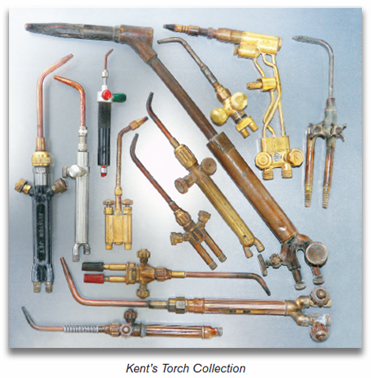TIG vs Torch
I have taught metalworking for over 25 years, and many of my students are convinced I don’t even own a TIG since I’m such a proponent of the torch. Not true. There are definitely times for using the TIG, but for most of my work the torch is usually the better choice. This does not mean it is the better choice for you, at least not all the time. It really depends on what you need to do. If, like me, you find yourself working on metal that needs to be bent, rolled, hammered, or shaped in some way (auto or aircraft restoration, tank construction, repairs, etc.), then you’ll really appreciate the strength of the welds you get from gas welding (you can work the heck out of the metal, something you cannot do with your TIG welds which can crack, break, or leak). And if you need to braze or solder, then you do need a torch.
There are a lot of people out there who think oxy-fuel welding is obsolete. They are misinformed. There are many reasons why so many gas-welding setups are sold around the world every year. The top three reasons are versatility, price, and portability. A decent TIG can easily run you $1,200. A good welding torch (including hoses, regulators, and tips) is about $250 plus the cost of tank rental. A torch can do most of the jobs a TIG can do, and a lot of jobs a TIG can’t. (Forget toting your TIG out to the back forty to fix that broken tractor part.) While both the torch and the TIG are used for finesse work (where details matter as much as appearance and strength), close scrutiny has shown me that each process has benefits as well as drawbacks. Let me explain what I mean.
Everyone asks me what the results of a Torch vs. TIG competition would be. It’s a “guy thing.” Here is what long-time welders admit when closely queried about such things as speeds, metals, thicknesses, distortion, and penetration.

On steel at thicknesses from .032 to ¼" the torch and the TIG are pretty equal on speed, but the torch can have better penetration on 4130 tubing. On thicker sections, the TIG goes faster because of its start-up heat. Distortion is pretty much the same.
On aluminum from .032 to 3/16" the torch wins on penetration, and the TIG has to weld both sides, or it needs a constant back-purge of inert gas during the welding operation. Distortion is equal or slightly better with the torch. The torch wins flat-out on speed and leak resistance on tanks. The TIG has inherent weld-density issues because it boils the aluminum inside the weld bead, leaving more leaks on aluminum tanks.
Stainless from .032 to 1/8" has the TIG winning by a bit on distortion and by a lot on cleanup. Penetration on tubing and flatwork is the same (if the TIG uses a back-up flux or a back-purge).
Cast iron gives the torch a big win on machinability and speed, because of the preheat that is required for welding cast iron. Doing cylinder head repairs on rare 4-valve Harley or Indian heads will really make you toe the line. And, the torch wins flat out on porosity â if the correct flux and eyewear are used.
On copper, from .032" to .090" the TIG wins on cleanup if it can get penetration, otherwise the torch wins on penetration, and both are equal on distortion. The TIG wins on speed.
The TIG wins flat out on titanium and some alloys of aluminum, like 5086 and 5083. The torch was used successfully for welding magnesium until November of 1942 when Northrup invented the “Heliarc” to combat the problem of excess oxygen in the torch flame which would cause the magnesium to burn.
What can the Torch do that the TIG can’t? The TIG is a non-starter for hot bending, annealing, normalizing 4130, brazing, silver brazing, and soldering. And forget trying to use your TIG in windy conditions. So if you need to fix that metal fence or boat, you better hope there’s not the slightest breeze blowing. (If you can get your TIG out to the yard to fix them.)
So⦠summing up, there are many cases where I don’t even think before I pick up the torch. On the other hand, there are times when I stop and debate about the time it takes to set up the TIG for a welding operation. Basically, on heavy stuff I grab the TIG. Be forewarned, the least sign of dirt or oil will give your TIG fits (e.g. doing repairs on exhaust tubing, crankcases, or old aluminum sheet). May God help you, should you decide to use the TIG in these instances! For the competition-minded I will have finished the dirty job and my lunch before the TIG is even halfway through. And I put money on this every so often.




